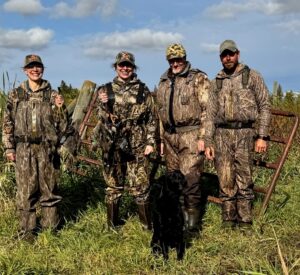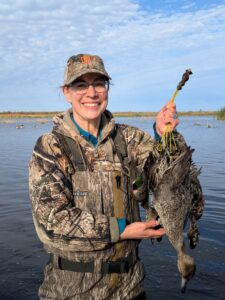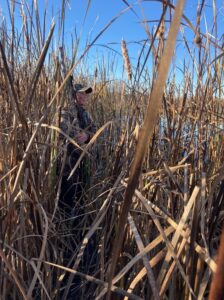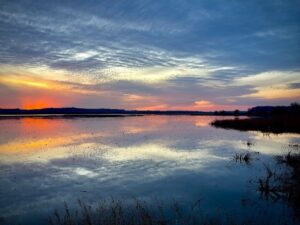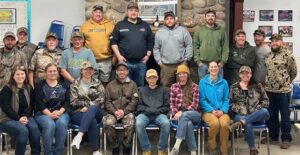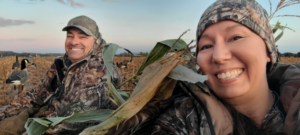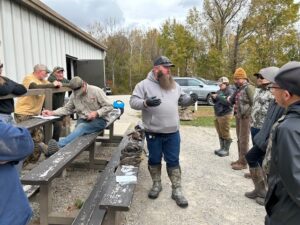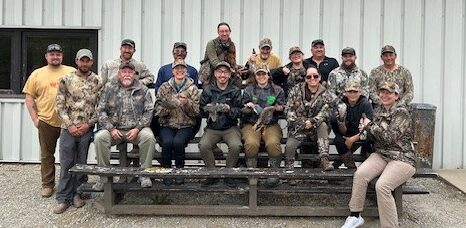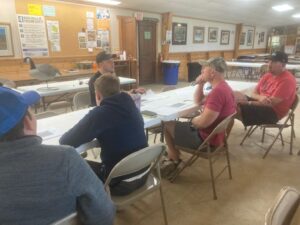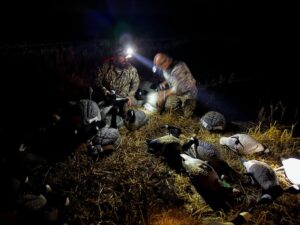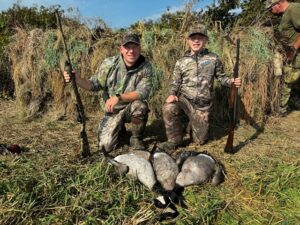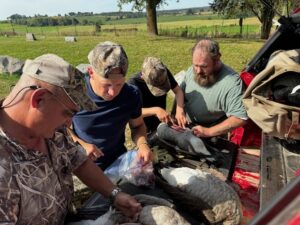By Sarah A. Orlofske, University of Wisconsin – Stevens Point
This article originally appeared in Wisconsin Waterfowl Association’s January, 2025 Newsletter edition.
Wetlands have been a part of my life since childhood and these early adventures inspired my career in wetland ecology. For the better part of a decade, I have also had the privilege of working with the waterfowling community, united by our shared love of wetlands and their most charismatic and ecologically important inhabitants. Throughout this time my primary activities have been recruiting hunters to donate specimens for our research. (You can see some of the results of this research here. I am incredibly grateful to all the hunters who have donated to our research over the years! Even though I had been so close to waterfowling all this time, I had never been waterfowl hunting myself. That changed this year at the Wisconsin Waterfowl Association Green Bay Chapter’s Learn to Hunt event. It may sound like an overstatement, but the experience was life changing!
The Friday evening activities started with classroom lessons, and I was enlightened by the information and expertise shared by the instructors and mentors and just how much was packed into a short meeting! The time on the shooting range afterward was helpful to refresh my skills and more importantly build my confidence, both of which were rusty from years away from a shotgun. I was impressed by the breadth of knowledge of the instructors and mentors. Their patience in answering my numerous questions and making sure I felt prepared was greatly appreciated!
I don’t think I slept much at all that night with all the excitement. We set out for the site at 3:30 AM. When we arrived, it was still completely dark as we loaded gear and dog into boats and put on our waders. The marsh was already noisy with geese and other active wildlife as we paddled out to our location and got everything set up. I have done a lot of wetland fieldwork but this was different – the setting, watching the sun rise, the camaraderie of others out in the field. I was impressed by the skill of my mentors in setting the decoys up and positioning ourselves in a stand of cattails. I will never forget my mentor setting out his special decoys hand carved by his father ready for another memorable day in the marsh.
My first shots were early, just after the official opening and I slipped in the mud and missed, but as my nerves calmed and my balance improved, I got wrapped up in watching the sky and listening to my mentor with his expert calling ability. I remember seeing the ducks from underneath, right above my head, and how they responded to the decoys and the calls. Their reaction time and their flight were so unexpectedly fast! My mentor was faster as he called out instructions to me, somehow never seeming to stop calling at the same time. I got a good look at a duck coming in from my left and took a couple of shots with the duck falling with the last one. The dog was out in a flash to retrieve it and I was amazed at the speed and skill used to locate and return the bird to us. A true partnership of hunter and canine companion, who seemed to love the experience just as much as the humans, if not more! My first duck was a hen pintail. Pintails have been my favorite ducks since childhood and that made the moment even more special.
As the morning continued, I admired how the marsh changed as the birds came by in waves. Sometimes just one or two, others in larger flocks. I missed some, but I was also successful too. Unexpectedly, a pair of ringnecks came in between myself and the other mentee and she got the drake and I got the hen and they fell near by each other. I think our mentors were just as excited as we were! We both had an outstanding hunt. I returned with five total ducks with a mix of species and the other mentee had four, which combined were a diverse sub-sample of the species of ducks we saw that day.
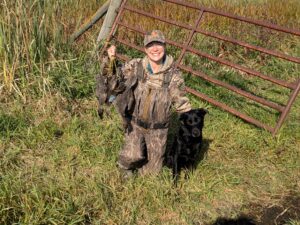 I was exhausted and exhilarated at the same time! I was really cold – my fieldwork typically ends when waterfowl season starts, so the cold temperatures caught me off guard – and my arms were completely worn out, but I couldn’t wait to tell anyone who would listen about my hunt. I treasured the experience that put me “backstage”. I had been so close to waterfowling for so long that it made the experience that much more rewarding. I got to see the pros in action and to be able to take part in all of the rituals and practices. It was like being on stage with your favorite music artist. I now better understood everything that happened leading up to the donation of the breasted-out carcasses and it made those donations even more special.
I was exhausted and exhilarated at the same time! I was really cold – my fieldwork typically ends when waterfowl season starts, so the cold temperatures caught me off guard – and my arms were completely worn out, but I couldn’t wait to tell anyone who would listen about my hunt. I treasured the experience that put me “backstage”. I had been so close to waterfowling for so long that it made the experience that much more rewarding. I got to see the pros in action and to be able to take part in all of the rituals and practices. It was like being on stage with your favorite music artist. I now better understood everything that happened leading up to the donation of the breasted-out carcasses and it made those donations even more special.
Our research seems even more connected to the waterfowl community now. These birds will be used in every possible way – as a delicious and nourishing meal to be shared with family and as specimens for research. For the first time, I will be proud to discover new scientific knowledge with birds I harvested myself.
The whole experience left me grateful, inspired and a bit overwhelmed. I realized what I knew and how much I still had to learn. I need warmer clothes and more practice with a shotgun, but I also have a strong desire to learn more, make more connections and pursue a future opportunity to get out again “backstage” to encounter waterfowl as both scientist and hunter.

